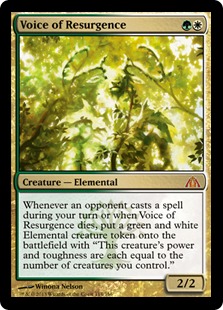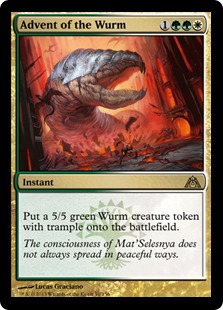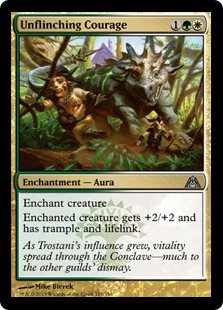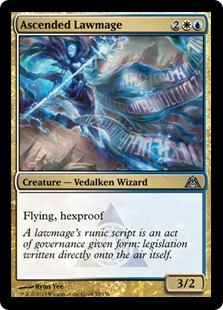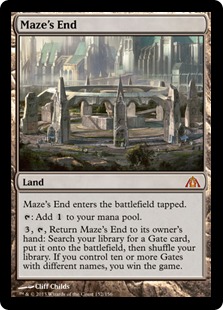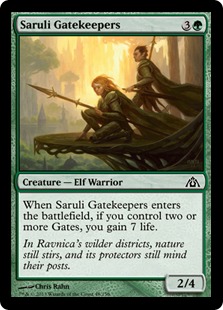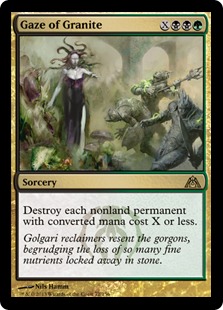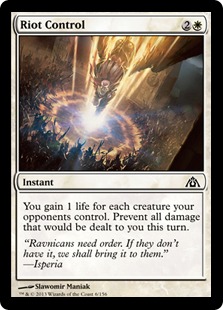Hello! Just a few days separate us from Dragon’s Maze Standard, so it’s time to brew something for the first week. I always start with aggressive decks because they’re easier to build properly, and this set will be no exception. Dragon’s Maze didn’t give us a lot of playables, but there is some spice in my favorite color combination: green/white. This time I have a little bonus at the end of the article, but everything should be done in order, so let’s listen to the voice.
Voice of Resurgence is the card that excites me the most in the entire set. It’s extremely powerful and versatile. Yes, it loses to Pillar of Flame (and it will be the reason that Pillar of Flame will see more play), but so does Strangleroot Geist. Voice of Resurgence is much better against Azorius Charm and may even force the opponent to cast Restoration Angel pre-combat in response to your tiny creature. The worst case is Supreme Verdict, as a 1/1 token afterward isn’t very impressive, but it’s not very common, while a 3/3 or 4/4 token is real and has already stolen some games in my testing.
I really wanted to play Voice of Resurgence in an aggressive shell, but I don’t think it’ll able to bring back straight G/W aggressive decks. They would simply be a turn slower than Mono-Red Aggro and Naya Blitz. My following experiments with Dreg Mangler and G/W/B mimics of Jund Aggro predictably failed; it’s great to cast hasty creature like Dreg Mangler and Strangleroot Geist right after Supreme Verdict and attack with a 2/2 token, but these decks badly needed Hellrider or Falkenrath Aristocrat. The latter can’t be used because four colors is unachievable, and the former isn’t the real deal since Voice of Resurgence becomes the weakest link of the deck due to the lack of synergy with Burning-Tree Emissary.
So, as you might imagine, most of my attempts eventually became the well-known R/G Aggro or Jund Aggro without a touch of white.The most realistic Voice of Resurgence deck I built looks like this:
Creatures (26)
- 2 Strangleroot Geist
- 3 Hellrider
- 3 Thundermaw Hellkite
- 4 Flinthoof Boar
- 4 Loxodon Smiter
- 4 Burning-Tree Emissary
- 3 Gyre Sage
- 3 Voice of Resurgence
Planeswalkers (4)
Lands (24)
Spells (6)

I tried versions with Call of the Conclave, but I eventually settled on an updated version of Eric Froehlich’s list from Pro Tour Gatecrash. While Voice of Resurgence and Advent of the Wurm improve your matchup against control, the deck is still relatively poorly positioned in the current metagame, and I don’t expect it to shift enough even though the recent success of Mono-Red Aggro may help (fighting against slower red decks is much easier than beating Naya Blitz).
A “proper” tokens deck is another approach for Voice of Resurgence because it gives the deck a reasonable early game. Advent of the Wurm may (or may not) be the thing to turn on populate in Constructed—I’ve even seen attempts with Wake the Reflections! Being more realistic, we can rely on Rootborn Defenses and new cards to beat control decks, which seem to be a nightmare for midrange token strategies. Advent of the Wurm also partially solves this deck’s weakness of only playing on its own turn, while Voice of Resurgence forces opponents to play more cards during their own turns. As a result, games of Magic are made fairer than they used to be.
Creatures (15)
Planeswalkers (3)
Lands (23)
Spells (19)

Scion of Vitu-Ghazi isn’t the best card in the world, but it’s reasonably good after Supreme Verdict and may be very impressive if you can populate, well, anything larger than a Bird. Intangible Virtue makes literally any token a legitimate threat and could help make G/W/B Tokens a contender for the title of “Best Midrange Deck” of the format without weird splashes for Huntmaster of the Fells or Master Biomancer. [Editor’s Note: Jund will probably win that award, but here’s to wishful thinking!]
And, as usual, I’m going to promote my favorite card of Return to Ravnica: Selesnya Charm. The card is extremely versatile—it provides early game against Naya Blitz, saves Voice of Resurgence from Pillar of Flame, and deals with huge monsters like Angel of Serenity.
The sideboard includes Putrefy and Ground Seal alongside a bevy of cards with the populate mechanic. Druid’s Deliverance isn’t as good as I’d like for it to be, but it’s reasonably good against Naya Blitz on the crucial turns of the game (turns 3 and 4) when you’re able to populate…well, anything able to block.
My third idea for Voice of Resurgence includes another new G/W card. Can you guess which one? No, not Advent of the Wurm this time. Unflinching Courage is an interesting choice for Bant Hexproof, and Voice of Resurgence is too. The last piece is Ascended Lawmage, who’s slow but may compensate for the deck’s lack of many hexproof creatures. However, the main method to make up for it is the use of good (and, if possible, cheap) non-hexproof creatures like Fencing Ace, Strangleroot Geist, and Loxodon Smiter.
Voice of Resurgence isn’t as good of an all-in creature as Fencing Ace is, but if you have a fear of things going wrong, it isn’t a bad choice. Like Strangleroot Geist, Voice of Resurgence is two creatures in one, so it doesn’t exchange two for one with an instant speed removal spell in response to an Aura. Additionally, Voice of Resurgence is much better against Azorius Charm—I’ve said that a lot today, haven’t I?—and its token may be devastating with mana dorks and Silverblade Paladin. Loxodon Smiter is more reliable in this aspect, but resilience could be better overall and allow Voice of Resurgence to exchange both cards.
Unflinching Courage is the second lifelink source after Gift of Orzhova; you may remember that the lifelink of Daybreak Coronet is one of the most important features of the similar and faster Modern Slippery Bogle deck. Unlike Infect, this deck must deal the full twenty points of damage (maybe even more after Thragtusk or Centaur Healer), so massive creatures with lifelink are the best way to win the race.
Actually, two three mana Auras compete for the same slot in the deck. Playing more than four is a mistake, but they’re good in slightly different situations, so both could see play. Both cards grant evasion to your creatures, but while flying is actually better than trample, larger pumping is better with both Invisible Stalker and Ascended Lawmage (for example, a 5/4 doesn’t exchange with Restoration Angel while a 4/3 does). The last point about these Auras is that Unflinching Courage is much easier to cast than the double white necessary for Gift of Orzhova (for which some players actually put Overgrown Tombs into their Bant decks).
Creatures (20)
- 4 Invisible Stalker
- 4 Avacyn's Pilgrim
- 4 Geist of Saint Traft
- 2 Silverblade Paladin
- 4 Voice of Resurgence
- 2 Ascended Lawmage
Lands (22)
Spells (18)
Sideboard

I’m not sure if there should be Selesnya Charm or Simic Charm maindeck. The latter is very interesting with Voice of Resurgence, but I’m not sure if that’s enough to justify its inclusion. The rest of the deck is well known and probably obvious, so I won’t spend any more time on it. Maze’s End is waiting!
Bonus Section: Maze’s End
Maze’s End is a funny card that seems unplayable, but it strongly reminds me of cards like Door to Nothingness and Battle of Wits, which allow players to have some fun and win some matches in Standard. Unfortunately, the Standard environment is very unfriendly towards Maze’s End because it doesn’t forgive you being a turn slower than a normal deck and, more importantly, Acidic Slime into any Gate may completely ruin your game. In contrast, Block Constructed almost lacks playable land destruction, and a slower deck may actually be playable there, so if you’re seeking Maze’s End fun you should take a look at Block Constructed.
Early testing showed that the shell is definitely playable, although the Mono-Red Aggro matchup is very bad. The best thing about the Maze’s End deck is that you don’t have to waste slots on extra win conditions and can simply put 35 good answers in alongside lands. The win condition itself looks awfully slow, but in fact it’s fast enough to win the game after you’ve stabilized and before you’re dead to the opponent’s topdecks. The first version is the following:
Creatures (9)
Planeswalkers (3)
Lands (25)
- 2 Forest
- 1 Overgrown Tomb
- 2 Temple Garden
- 1 Watery Grave
- 1 Godless Shrine
- 1 Stomping Ground
- 1 Blood Crypt
- 1 Breeding Pool
- 1 Hallowed Fountain
- 1 Golgari Guildgate
- 1 Izzet Guildgate
- 1 Azorius Guildgate
- 1 Rakdos Guildgate
- 1 Selesnya Guildgate
- 1 Simic Guildgate
- 1 Gruul Guildgate
- 1 Dimir Guildgate
- 1 Boros Guildgate
- 1 Orzhov Guildgate
- 4 Maze's End
Spells (23)
- 1 Putrefy
- 4 Azorius Charm
- 2 Abrupt Decay
- 4 Supreme Verdict
- 2 Detention Sphere
- 4 Sphinx's Revelation
- 1 Selesnya Charm
- 1 Treasured Find
- 1 Urban Evolution
- 2 Aetherize
- 1 Devour Flesh
Sideboard

This list is obviously very rough and requires a lot of fine-tuning, but there’s some hope behind it. You typically hit three or four Gates during the course of the game and then need about six turns to win through Maze’s End, which is reasonable after you stabilize. Saruli Gatekeepers is awesome at helping you survive, especially against decks that can’t attack with Foundry Street Denizen, and removal does the job before you start casting Sphinx’s Revelations. The mana base is a little bit special, but it actually supports most of the non-double mana costs well, so there’s a lot of space for tuning and choosing the best cards among all five colors (actually four since there aren’t many red cards for the deck).
The deck’s main problem is the lack of a second Supreme Verdict effect since it’s often crucial to sweep the board early (that’s why Merciless Eviction and Street Spasm can’t be used). I finally set on Aetherize as the second (bad) Supreme Verdict effect, but Gaze of Granite may be reasonable depending on the environment.
Another way to overcome the lack of a second Supreme Verdict is to put Riot Control in the maindeck and add a second Fog effect (probably Druid’s Deliverance since Hindervines is bad against unleash) to build a Turbo Fog deck. Maze’s End is too slow as a win condition for Turbo Fog in Standard, but it’s good enough for Block Constructed, especially if you build with the popular Esper Control in mind.
That’s all for today. Have fun playing Dragon’s Maze Standard!
 |
I am Izzet. When I saw the guilds for the first time, I was 146% sure that I was Izzet. My job is a research engineer, so it’s predicable that The Izzet in me is Curiosity. Everything I do is because of Curiosity. I just want Whenever Dracogenius needs an investigator, he can count on me. |

